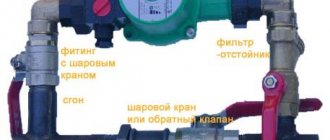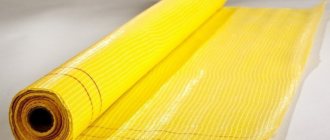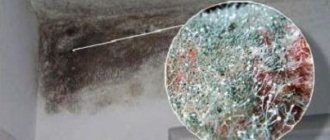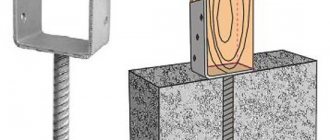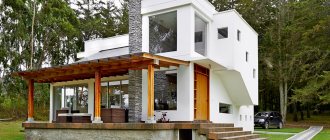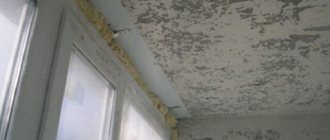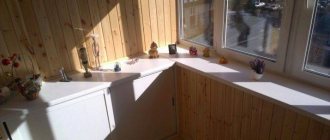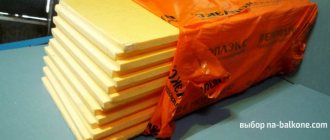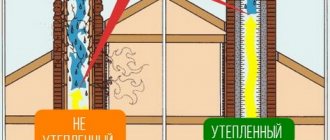There have always been problems with the formation of moisture in the under-roof space; any builder will confirm that condensation on the roof appears constantly, depending on the time of year, weather, ceiling design and the state of attic ventilation. Therefore, it would be correct to periodically check the condition of the roof and monitor the appearance of condensed moisture.
Consequences of condensation on the roof of a house
The appearance of water on the eaves, on the drip, or in the gutters does not mean that the roof insulation system has failed. Most likely, the ventilation performance of the under-roof space is insufficient due to low air temperature, and water vapor is removed by the membrane. It’s another matter if condensation drips from the roof from inside the room.
In this case, it is extremely important to identify the formation of condensed moisture in time and, at a minimum, look for a way to eliminate condensation on the roof before the problem becomes critical.
From a large list of serious problems, you need to pay attention to two factors:
- Watering of the insulating layer. Condensation on the roof insulation quickly negates the heat-insulating properties of mineral fiber or even expanded polystyrene; moisture-filled cold bridges become overgrown with ice and snow in frosty weather;
- Deformation, cracking and rotting of the wood of rafter beams. Excess moisture kills rafters and sheathing, creating conditions for roof settlement and the spread of fungus.
For your information!
The first sign of a ventilation malfunction or waterproofing damage is a swampy smell in the summer; in winter, problems with condensation can be identified by the formation of ice plugs on the roof gables. Sometimes, due to the accumulation of condensation on a corrugated roof, the sheathing arches and lifts sheets of roofing material. In this situation, you have to change the insulation and vapor barrier membrane without waiting for warm weather.
Laminate - what kind of material is it?
It must be said right away that laminate flooring is distinguished by high performance characteristics, which are many times superior to expensive analogues. The material is based on the structure of wood, which makes it environmentally friendly. Thanks to the size and shape, installation is quick and convenient, and most importantly, such work does not require knowledge, which allows you to install the laminated flooring yourself.
Despite the characteristics of the material, it, like other flooring, is characterized by low resistance to moisture, which entails bad consequences:
- Severe deformation of laminated panels.
- The reliability of the locking mechanism weakens, which can lead to severe loosening and even breakage of the panels.
- Gaps appear between the joints.
- The strength characteristics of the material are greatly reduced.
Laminated panels
To lay laminate flooring, you need to carefully prepare the surface, it must be
flat. To do this, perform a screed. It is important to choose and lay the underlay correctly under such flooring; the quality of subsequent operation of the warm laminated floor depends on this, and the problem of condensation formation will be resolved in a positive way.
Advice! Today there is an excellent alternative to cement screed - self-leveling mixtures that allow you to quickly and easily create a smooth surface.
Why does condensation form on the roof?
Despite all the variety of explanations and ingenious theories, the formation of condensed water requires vapor and a surface, preferably metal, with high thermal conductivity. During the process of contact and air-steam flow around a cold surface, water falls out in the form of droplets and is held on the film, wood, and metal by surface tension forces.
In order for condensation to form, a source of warm water vapor is needed, usually a stove or moisture exhaled by the occupants of the house. Cold air, supersaturated with evaporated water, has high density and limited mobility. The slightest contact with a surface whose temperature is less than 4°C leads to the formation of a cold film of condensation. Remains of cold air and water vapor settle on the ground, vapor barrier or ceilings and do not pose a particular danger to the roof.
This mixture can form condensation in a cold attic in the spring and fall, especially if the house is located near a body of water. Most often, such a flow falls in the form of fog, but this moisture quickly disappears and does not cause harm to roofing structures.
Warm steam is another matter; it has enough heat reserve to break through an incorrectly laid vapor barrier of the ceiling and remain in the attic for a long time, penetrating into the insulation and under-roof space.
The reasons why condensation accumulates under the roof may be the following factors:
- Inadequate quality of waterproofing and vapor barrier of the ceiling and the roof itself;
- Lack of ventilation in the attic or roof space of a residential building.
For each of the existing schemes for constructing a roofing pie, there is its own reason for the accumulation of water, so it would be correct to understand the mechanism before trying to get rid of condensation on the roof.
The appearance of condensed water on a classic roof
The most common cause of condensation inside the attic is poor roof insulation. In this case, the dew point or the conventional separation line of the thermal insulation is located on the inside of the roofing pie. Its surface temperature in winter ranges from -5°C to +6°C.
It is on the inner film that all the condensation from the vapors that have leaked into the attic through the ceiling falls out.
The second reason is the lack of a ventilation gap between the roof and the vapor barrier laid on the sheathing. Sometimes a vapor barrier membrane is laid directly on the surface of the insulation. This is wrong, the insulating sheet always absorbs condensation and removes it, either through accumulation on the gutters, or releases it to the air flow flowing through the ventilation ducts under the roof. This situation rarely happens, but it is precisely this that causes the roof insulation to become soaked and damage to the sheathing.
The essence of condensate
There is no such thing as absolutely dry air. It always contains a certain percentage of moisture. If the air is oversaturated with moisture (passes the dew point), its excess falls to the surface in the form of small drops.
Typically, excess moisture appears on the surface with the lowest temperature. This is due to the fact that the dew point is not a fixed value, but a variable one.
The occurrence of condensation depends not only on the saturation of air with vapor, but also on its temperature. The colder the room, the lower the percentage of humidity that condensation will form.
Problems with condensation on an uninsulated roof
There is a widespread belief among amateur developers that on cold and uninsulated roofs there is no particular need to use a vapor barrier or generally deal with water vapor. This is only partly true; it all depends on the design of the ceiling and the method of its insulation.
According to SanPiN standards, walls and ceilings must have residual vapor permeability; this is the most effective way to ensure the sanitization of the interior decoration of a room. In this case, the ceiling is thermally insulated and covered with a vapor barrier membrane, the vapors escape through the ceiling and, accordingly, form condensation on the insulation of the cold attic.
If full-fledged supply and exhaust ventilation of the attic is installed on the roof gables, then the sheathing does not need to be covered with an insulating sheet. But it is also impossible to increase ventilation excessively, since the room under the roof will freeze, and condensation will freeze on the vapor barrier.
The opposite situation is that in the absence of ventilation, condensation will begin to accumulate under the roof with all the ensuing consequences, including rotting of the lining and sheathing of the roof covering.
The third option involves finishing with waterproofing on the inside of a warm ceiling and an uninsulated roof. Hot water vapor remains indoors and is removed using room ventilation. Of all the options, this provides the lowest level of comfort and will still require underlayment of the roof sheathing.
For your information! Even with thermal insulation, a certain amount of thermal energy is transferred through the ceiling into the attic from the room or chimney.
Due to this, the moist air in the attic is heated and rises under the roof covering. If an uninsulated sheathing is covered with a metal sheet, corrugated sheet or metal tile, then the amount of condensation will be simply enormous, especially in the latter case. Methods for eliminating condensation on a metal tile roof involve the use of special types of lining fabric and more massive sheathing.
Why is condensation dangerous in the house?
Condensation can lead to wetness of the insulation of the ceiling and walls. As a result, its quality will gradually decrease and after some time the heat will be retained less efficiently. Then the house will first become cold, then damp. A frame house does not tolerate dampness well: the wooden foundations of a frame house may collapse, and the house may even become uninhabitable. Corrosion processes may begin in metal structures.
Dampness can also lead to mold, which spreads all kinds of diseases.
Mold, which is hazardous to health, is a frequent companion of condensation.
Condensation on the attic roof
Similar processes occur in attics. In the construction of an attic floor, as a rule, waterproofing of the ceiling between the first and second floors and a warm roof are installed. Condensation forms especially intensively on the side overhangs and in the ceiling space under the ridge.
To remove condensation on an attic roof, use:
- Multilayer fiber membranes with one-way conductivity of water vapor. In this case, excess moisture is filtered by the canvas and released in liquid and vapor form into the ventilation ducts of the roof covering;
- Ventilation ducts installed in the gap between the roof surface and the vapor barrier;
- Dormer windows are installed, with the help of which it is possible to effectively ventilate and remove excess moisture from the attic room.
The exception is broken roofs; in this case, condensation on the attic roof is removed in a complex way. The upper planes of the slopes are equipped with ventilation and vents; on the lower pair, vapor barrier fiber membranes are additionally installed. Condensation is absorbed into the canvas and flows under its own weight and accumulates in the gutters.
Roof leakage
Strange, but leaking roofs are not the cause of deterioration of materials. It could even be a newly erected building, but the problem with leakage is already present, so if your corrugated roof is leaking in your house, you shouldn’t immediately ask what to do, you need to first figure out the reasons, but do it quickly.
Let's look at some types of leaks.
- A leak occurs immediately after precipitation in the form of rain or after a short period of time
- Leakage does not occur every time after rain
- The melting of snow cover in the spring is the cause of leakage
- As a result of the operation of the building in winter
The most common cause of leaks is mistakes made during the installation process or at the design stage. As an example, I will give the following violations:
- The angle of inclination for the roof was calculated incorrectly
- The wave height of the profile metal is incorrectly selected. With strong gusts of wind, moisture can be blown into the joints of the sheets
- Sealant for corrugated roofing was used in small quantities or was absent altogether. By the way, in a hardware store you can find a fairly large selection of this product, for example, based on silicone, polyurethane, acrylic. There are also thiokol sealant and special butyl rubber tape.
- The protective waterproofing layer is damaged
- Mechanical damage to the coating during installation work that was not paid attention to
- Product defects
- Poor quality roofing materials
- Failure of the coating due to the end of its service life
The process of roof leakage in winter is of greatest interest. Of course, there is nothing exciting about the problem itself, but possible causes need to be identified as soon as possible. As a rule, the whole problem lies in the incorrect organization of the temperature regime of the attic. Due to high temperatures, the roof covering itself has a positive temperature, therefore, the snow begins to melt and water gets inside through the broken seal.
As you already understand, all of the above types of leakage are also possible in winter, and not only at above-zero temperatures.
What to do if there is condensation on the roof
The method of how to get rid of condensation in the attic must be selected depending on the structure of the roof. First of all, it is necessary to dismantle the insulation and open the areas where the roof is stuck.
For cold roofs and insulated ceilings, the only way to get rid of the rafters and sheathing getting stuck is to provide room ventilation. To enhance the removal of condensate, an additional pipe is installed in the attic, the height of which should be 40-50 cm above the ridge beam, and air flow is made through the filing of the eaves.
For an insulated roof, the most effective way is to increase the vents and ventilation ducts under the roofing. Ventilation pipes are installed on the surface of the slopes, often reinforced with deflectors and built-in electric fans. In this case, you can get rid of condensation even in unfavorable conditions of the autumn-winter period of the year. If condensation gets into the mineral wool, you will need to dismantle the roof and completely replace the insulation.
What to do and how to get rid of condensation on the ceiling, floor in the cellar, basement
To get rid of excessive condensation, you need to eliminate all possible factors affecting moisture retention. To this end, a number of measures are being taken to ensure the proper functioning of the systems inside the basement:
- waterproofing;
- thermal insulation;
- restoration of high-quality ventilation;
- setting up drainage systems;
Important! Before you begin to deal with condensation in the cellar, it is necessary to conduct a complete diagnosis of the problems by analyzing the condition of the room.
Preventing condensation under the roof
The only effective and safe way to prevent the formation and accumulation of condensation is to maintain the ventilation of the roof space in working order. Over time, vents and ventilation ducts become clogged with dust, debris, plant seeds and insects, so entrance soffits and windows are regularly inspected and blown out with compressed air.
The outlet openings located along the ridge strip may freeze and become covered with ice in winter. Therefore, ventilation, like gutters and drips on eaves, is often equipped with a heating electric cable. This ensures that condensation is removed even in the event of severe icing.
Tips and tricks
The best way to protect the insulation and load-bearing structures of the rafter system is to insulate the roof, gables and ceiling. But thermal insulation alone is not enough, so the attic space must be equipped with supply and exhaust ventilation.
Modern electric fans provide high air performance, and automation allows you to turn on ventilation only in case of emergency, based on a signal from a water film formation sensor. In this way, it is possible to save heat and protect the insulation from moisture.


